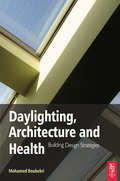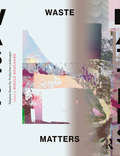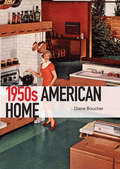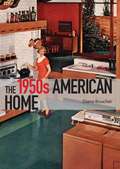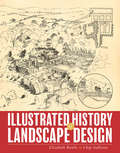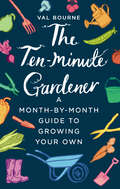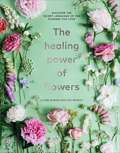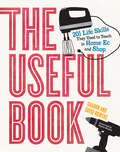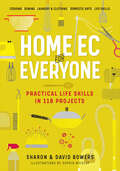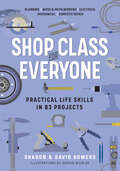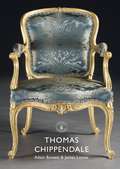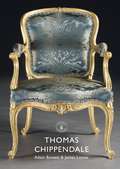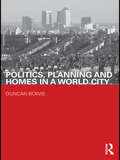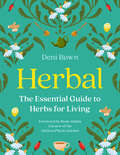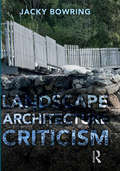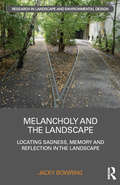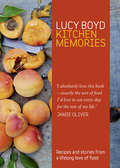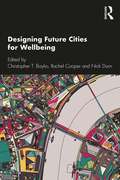- Table View
- List View
Daylighting, Architecture and Health
by Mohamed BoubekriDaylighting, Architecture and Health examines the relationship between natural light in buildings and human health, considering both psychological and physiological issues and bringing together a range of research in the field. As we are becoming increasingly conscious of global warming and pushing towards energy efficiency in buildings, the book examines the question of daylighting from the perspective of the health of building occupants. It gathers and reviews all the latest and pertinent medical and architectural research related to natural light, or lack thereof, and its effect on people.* Documents medical research findings which establish a link between light quality and health* Considers design strategies for increasing daylight in buildings* Develops understanding and awareness of the importance of natural light in buildingsDaylighting, Architecture and Health: Building Design Strategies is a timely and essential text for professional architects and all others concerned with the effects of daylighting on health, architecture and building design.
Daylighting, Architecture and Health
by Mohamed BoubekriDaylighting, Architecture and Health examines the relationship between natural light in buildings and human health, considering both psychological and physiological issues and bringing together a range of research in the field. As we are becoming increasingly conscious of global warming and pushing towards energy efficiency in buildings, the book examines the question of daylighting from the perspective of the health of building occupants. It gathers and reviews all the latest and pertinent medical and architectural research related to natural light, or lack thereof, and its effect on people.* Documents medical research findings which establish a link between light quality and health* Considers design strategies for increasing daylight in buildings* Develops understanding and awareness of the importance of natural light in buildingsDaylighting, Architecture and Health: Building Design Strategies is a timely and essential text for professional architects and all others concerned with the effects of daylighting on health, architecture and building design.
Waste Matters: Adaptive Reuse for Productive Landscapes
by Nikole BouchardFor thousands of years humans have experimented with various methods of waste disposal—from burning and burying to simply packing up and moving in search of an unscathed environment. Habits of disposal are deeply ingrained in our daily lives, so casual and continual that we rarely ever stop to ponder the big-picture effects on social, spatial and ecological orders. Rethinking the ways in which we produce, collect, discard and reuse our waste, whether it’s materials, spaces or places, is essential to ensure a more feasible future. Waste Matters: Adaptive Reuse for Productive Landscapes presents a series of historical and contemporary design ideas that reimagine a range of repurposed materials at diverse scales and in various contexts by exploring methods of hacking, disassembly, reassembly, recycling, adaptive reuse and preservation of the built environment. Waste Matters will inspire designers to sample and rearrange bits of artifacts from the past and present to produce culturally relevant and ecologically sensitive materials, objects, architecture and environments.
Waste Matters: Adaptive Reuse for Productive Landscapes
by Nikole BouchardFor thousands of years humans have experimented with various methods of waste disposal—from burning and burying to simply packing up and moving in search of an unscathed environment. Habits of disposal are deeply ingrained in our daily lives, so casual and continual that we rarely ever stop to ponder the big-picture effects on social, spatial and ecological orders. Rethinking the ways in which we produce, collect, discard and reuse our waste, whether it’s materials, spaces or places, is essential to ensure a more feasible future. Waste Matters: Adaptive Reuse for Productive Landscapes presents a series of historical and contemporary design ideas that reimagine a range of repurposed materials at diverse scales and in various contexts by exploring methods of hacking, disassembly, reassembly, recycling, adaptive reuse and preservation of the built environment. Waste Matters will inspire designers to sample and rearrange bits of artifacts from the past and present to produce culturally relevant and ecologically sensitive materials, objects, architecture and environments.
The 1950s American Home (Shire Library USA #740)
by Diane BoucherModern living began with the homes of the 1950s. Casting aside the privations of the Second World War, American architects embraced the must-have mod-cons: they wrapped fitted kitchens around fridges, washing machines, dishwashers and electric ovens, gave televisions pride of place in the living room, and built integrated garages for enormous space-age cars. So why was this change so radical? In what ways did life change for people moving into these swanky new homes, and why has the legacy of the 1950s home endured for so long? Diane Boucher answers these questions and more in this colorful introduction to the homes that embody the golden age of modern design.
The 1950s American Home (Shire Library USA)
by Diane BoucherModern living began with the homes of the 1950s. Casting aside the privations of the Second World War, American architects embraced the must-have mod-cons: they wrapped fitted kitchens around fridges, washing machines, dishwashers and electric ovens, gave televisions pride of place in the living room, and built integrated garages for enormous space-age cars. So why was this change so radical? In what ways did life change for people moving into these swanky new homes, and why has the legacy of the 1950s home endured for so long? Diane Boucher answers these questions and more in this colorful introduction to the homes that embody the golden age of modern design.
Illustrated History of Landscape Design
by Elizabeth Boults Chip SullivanA visual journey through the history of landscape design For thousands of years, people have altered the meaning of space by reshaping nature. As an art form, these architectural landscape creations are stamped with societal imprints unique to their environment and place in time. Illustrated History of Landscape Design takes an optical sweep of the iconic landscapes constructed throughout the ages. Organized by century and geographic region, this highly visual reference uses hundreds of masterful pen-and-ink drawings to show how historical context and cultural connections can illuminate today's design possibilities. This guide includes: Storyboards, case studies, and visual narratives to portray spaces Plan, section, and elevation drawings of key spaces Summaries of design concepts, principles, and vocabularies Historic and contemporary works of art that illuminate a specific era Descriptions of how the landscape has been shaped over time in response to human need Directing both students and practitioners along a visually stimulating timeline, Illustrated History of Landscape Design is a valuable educational tool as well as an endless source ofinspiration.
Designing for Autism Spectrum Disorders
by Angela Bourne Michelle Pearson Kristi Gaines Mesha KleibrinkWinner of the 2017 IDEC Book Award, 2017 EDRA Great Places Award (Book Category), 2017 American Society of Interior Designers Joel Polsky Prize and the 2016 International Interior Design Association TXOK Research Award Designing for Autism Spectrum Disorders explains the influence of the natural and man-made environment on individuals with autism spectrum disorders (ASD) and other forms of intellectual/developmental disabilities (IDD). Drawing on the latest research in the fields of environmental psychology and education, the authors show you how architecture and interior spaces can positively influence individuals with neurodiversities by modifying factors such as color, lighting, space organization, textures, acoustics, and ventilation. Now you can design homes, therapeutic environments, work environments, and outdoor spaces to encourage growth and learning for the projected 500,000 children with ASD (in the United States alone) who are expected to reach adulthood by 2024. Topics discussed include:-Environmental design theories-Symptoms of ASD-Sensory processing deficits -Design needs of individuals on the spectrum at all ages-Design methods and solutions for spaces, including residential, learning, work, and therapeutic environments encompassing a wide range of budgets-Designing for self-actualization, well-being, and a high quality of life for the duration of an individual's life-Avenues for healthy living and aging in place-Biophilic design-Environmental impact on well-being -Strategies to promote active living as an integral part of the welfare focus.
Designing for Autism Spectrum Disorders
by Angela Bourne Michelle Pearson Kristi Gaines Mesha KleibrinkWinner of the 2017 IDEC Book Award, 2017 EDRA Great Places Award (Book Category), 2017 American Society of Interior Designers Joel Polsky Prize and the 2016 International Interior Design Association TXOK Research Award Designing for Autism Spectrum Disorders explains the influence of the natural and man-made environment on individuals with autism spectrum disorders (ASD) and other forms of intellectual/developmental disabilities (IDD). Drawing on the latest research in the fields of environmental psychology and education, the authors show you how architecture and interior spaces can positively influence individuals with neurodiversities by modifying factors such as color, lighting, space organization, textures, acoustics, and ventilation. Now you can design homes, therapeutic environments, work environments, and outdoor spaces to encourage growth and learning for the projected 500,000 children with ASD (in the United States alone) who are expected to reach adulthood by 2024. Topics discussed include:-Environmental design theories-Symptoms of ASD-Sensory processing deficits -Design needs of individuals on the spectrum at all ages-Design methods and solutions for spaces, including residential, learning, work, and therapeutic environments encompassing a wide range of budgets-Designing for self-actualization, well-being, and a high quality of life for the duration of an individual's life-Avenues for healthy living and aging in place-Biophilic design-Environmental impact on well-being -Strategies to promote active living as an integral part of the welfare focus.
The Ten-Minute Gardener: A month-by-month guide to growing your own (Ten-minute Gardener Ser.)
by Val BourneTHE PERFECT GIFT FOR GARDENERSWhether you have a spacious plot or a small patch in the garden, this handbook is full of tried-and-tested tips from a seasoned old hand. It offers practical month-by-month suggestions for making the most of the little time you can spare on both the coldest winter days and the long summer afternoons, with ideas to inspire even the most experienced allotment gardeners. Focusing on the essentials needed to produce a great crop, this is for those who want to but struggle to find the time to grow their own.For those who garden in snatched moments . . . *Combined and updated editions of The Ten Minute Gardener's Fruit-Growing Diary and The Ten Minute Gardener's Vegetable-Growing Diary*
The Healing Power of Flowers: discover the secret language of the flowers you love
by Claire BowenLive life in full bloom.This beautiful book features your favourite flowers grouped by their purpose – for love, for joy, for luck, for calm, to console, and to celebrate. Discover their traditional meanings, holistic benefits, and when flowers are in season so that they can be sourced locally with a minimal carbon footprint. By creating thoughtful personal bouquets or choosing a flower for its meaning, its natural energy, or holistic property, you can bring the benefits of the natural world back into your home, your workplace, and into the lives of loved ones. Find out why you should give Foxgloves to celebrate a new job, Lilacs for joy, or Chrysanthemums for luck, and become fluent in the secret language of flowers.
The Useful Book: 201 Life Skills They Used to Teach in Home Ec and Shop
by David Bowers Sharon BowersA modern and energetically designed encyclopedia of DIY with everything you need to know to roll up your sleeves and cook it, build it, sew it, clean it, or repair it yourself. In other words, everything you would have learned from your shop and home ec teachers, if you'd had them.The Useful Book features 138 practical projects and how-tos, with step-by-step instructions and illustrations, relevant charts, sidebars, lists, and handy toolboxes. There&’s a kitchen crash course, including the must-haves for a well-stocked pantry; how to boil an egg (and peel it frustration-free); how to grill, steam, sauté, and roast vegetables. There&’s Sewing 101, plus how to fold a fitted sheet, tie a tie, mop a floor, make a bed, and set the table for a formal dinner. Next up: a 21st-century shop class. The tools that everyone should have, and dozens of cool projects that teach fundamental techniques. Practice measuring, cutting, and nailing by building a birdhouse. Make a bookshelf or a riveted metal picture frame. Plus: do-it-yourself plumbing; car repair basics; and home maintenance, from priming and painting to refinishing wood floors.
Home Ec for Everyone: Cooking · Sewing · Laundry & Clothing · Domestic Arts · Life Skills
by Sharon Bowers David BowersClear step-by-step instructions for everything you would have been taught in Home Ec class: cooking and baking, sewing and mending, home-keeping tips, and more--in a stylish and easy-to-use reference guide for today's DIY'ers, homeowners and renters, new adults, and anyone who wants to be more self-sufficient at home.
Shop Class for Everyone: Plumbing · Wood & Metalwork · Electrical · Mechanical · Domestic Repair
by Sharon Bowers David BowersClear step-by-step instructions for everything you would have learned in shop class: woodwork, metalwork, wiring, and general home repair and maintenance, from how to hang a picture to how to replace a window pane. A stylish and easy-to-use home reference guide for today's DIYers, homeowners, new adults, and anyone who wants to be more self-sufficient at home.
Thomas Chippendale (Shire Library)
by Adam Bowett James LomaxFor at least 150 years, Thomas Chippendale has been synonymous with beautifully made eighteenth-century furniture in a variety of styles – Rococo, Chinese, Gothic and Neoclassical. Born in Otley, Yorkshire, in 1718, Chippendale rose to fame because of his revolutionary design book, The Gentleman and Cabinet Maker's Director, published in 1754. That same year he set up his famous workshops in St Martin's Lane, creating some of the most magnificent furniture ever made in Britain. This beautifully illustrated history focuses on Britain's most famous furniture maker and designer, including the worldwide phenomenon 'Chippendale style' that became popular in Europe, North America and Asia after his death in 1779. Today, his influence lives on with the ongoing production of 'Chippendale' furniture, while the eighteenth-century originals are selling for millions at auction.
Thomas Chippendale (Shire Library)
by Adam Bowett James LomaxFor at least 150 years, Thomas Chippendale has been synonymous with beautifully made eighteenth-century furniture in a variety of styles – Rococo, Chinese, Gothic and Neoclassical. Born in Otley, Yorkshire, in 1718, Chippendale rose to fame because of his revolutionary design book, The Gentleman and Cabinet Maker's Director, published in 1754. That same year he set up his famous workshops in St Martin's Lane, creating some of the most magnificent furniture ever made in Britain. This beautifully illustrated history focuses on Britain's most famous furniture maker and designer, including the worldwide phenomenon 'Chippendale style' that became popular in Europe, North America and Asia after his death in 1779. Today, his influence lives on with the ongoing production of 'Chippendale' furniture, while the eighteenth-century originals are selling for millions at auction.
Politics, Planning and Homes in a World City (Housing, Planning and Design Series)
by Duncan BowieThis is an insightful study of spatial planning and housing strategy in London, focusing on the period 2000-2008 and the Mayoralty of Ken Livingstone. Duncan Bowie presents a detailed analysis of the development of Livingstone’s policies and their consequences. Examining the theory and practice of spatial planning at a metropolitan level, Bowie examines the relationships between: planning, the residential development market and affordable housing environmental, economic and equity objectives national, regional and local planning agencies and their policies. It places Livingstone’s Mayoralty within its historical context and looks forward to the different challenges faced by Livingstone’s successors in a radically changed political and economic climate. Clear and engaging, this critical analysis provides a valuable resource for academics and their students as well as planning, housing and development professionals. It is essential reading for anyone interested in politics and social change in a leading ‘world city’ and provides a base for parallel studies of other major metropolitan regions.
Politics, Planning and Homes in a World City (Housing, Planning and Design Series)
by Duncan BowieThis is an insightful study of spatial planning and housing strategy in London, focusing on the period 2000-2008 and the Mayoralty of Ken Livingstone. Duncan Bowie presents a detailed analysis of the development of Livingstone’s policies and their consequences. Examining the theory and practice of spatial planning at a metropolitan level, Bowie examines the relationships between: planning, the residential development market and affordable housing environmental, economic and equity objectives national, regional and local planning agencies and their policies. It places Livingstone’s Mayoralty within its historical context and looks forward to the different challenges faced by Livingstone’s successors in a radically changed political and economic climate. Clear and engaging, this critical analysis provides a valuable resource for academics and their students as well as planning, housing and development professionals. It is essential reading for anyone interested in politics and social change in a leading ‘world city’ and provides a base for parallel studies of other major metropolitan regions.
Herbal: The Essential Guide To Herbs For Living
by Deni BownAs the New Year arrives with its seasonal colds, this book proves to be an invaluable companion for effective homeopathic relief.
Landscape Architecture Criticism
by Jacky BowringLandscape Architecture Criticism offers techniques, perspectives and theories which relate to landscape architecture, a field very different from the more well-known domains of art and architectural criticism. Throughout the book, Bowring delves into questions such as, how do we know if built or unbuilt works of landscape architecture are successful? What strategies are used to measure the success or failure, and by whom? Does design criticism only come in written form? It brings together diverse perspectives on criticism in landscape architecture, establishing a substantial point of reference for approaching design critique, exploring how criticism developed within the discipline. Beginning with an introductory overview to set the framework, the book then moves on to historical perspectives, the purpose of critique, theoretical positions ranging from aesthetics, to politics and experience, unbuilt projects, techniques, and communication. Written for professionals and academics, as well as for students and instructors in landscape architecture, it includes strategies, diagrams, matrices, and full colour illustrations to prompt discussion and provide a basis for exploring design critique.
Landscape Architecture Criticism
by Jacky BowringLandscape Architecture Criticism offers techniques, perspectives and theories which relate to landscape architecture, a field very different from the more well-known domains of art and architectural criticism. Throughout the book, Bowring delves into questions such as, how do we know if built or unbuilt works of landscape architecture are successful? What strategies are used to measure the success or failure, and by whom? Does design criticism only come in written form? It brings together diverse perspectives on criticism in landscape architecture, establishing a substantial point of reference for approaching design critique, exploring how criticism developed within the discipline. Beginning with an introductory overview to set the framework, the book then moves on to historical perspectives, the purpose of critique, theoretical positions ranging from aesthetics, to politics and experience, unbuilt projects, techniques, and communication. Written for professionals and academics, as well as for students and instructors in landscape architecture, it includes strategies, diagrams, matrices, and full colour illustrations to prompt discussion and provide a basis for exploring design critique.
Melancholy and the Landscape: Locating Sadness, Memory and Reflection in the Landscape (Routledge Research in Landscape and Environmental Design)
by Jacky BowringWritten as an advocacy of melancholy’s value as part of landscape experience, this book situates the concept within landscape’s aesthetic traditions, and reveals how it is a critical part of ethics and empathy. With a history that extends back to ancient times, melancholy has hovered at the edges of the appreciation of landscape, including the aesthetic exertions of the eighteenth-century. Implicated in the more formal categories of the Sublime and the Picturesque, melancholy captures the subtle condition of beautiful sadness. The book proposes a range of conditions which are conducive to melancholy, and presents examples from each, including: The Void, The Uncanny, Silence, Shadows and Darkness, Aura, Liminality, Fragments, Leavings, Submersion, Weathering and Patina.
Melancholy and the Landscape: Locating Sadness, Memory and Reflection in the Landscape (Routledge Research in Landscape and Environmental Design)
by Jacky BowringWritten as an advocacy of melancholy’s value as part of landscape experience, this book situates the concept within landscape’s aesthetic traditions, and reveals how it is a critical part of ethics and empathy. With a history that extends back to ancient times, melancholy has hovered at the edges of the appreciation of landscape, including the aesthetic exertions of the eighteenth-century. Implicated in the more formal categories of the Sublime and the Picturesque, melancholy captures the subtle condition of beautiful sadness. The book proposes a range of conditions which are conducive to melancholy, and presents examples from each, including: The Void, The Uncanny, Silence, Shadows and Darkness, Aura, Liminality, Fragments, Leavings, Submersion, Weathering and Patina.
Kitchen Memories: Recipes And Stories From A Lifelong Love Of Food
by Lucy BoydLucy Boyd, head gardener for Michelin-starred café Petersham Nurseries and trained chef understands ingredients, and knows how to turn them into extraordinary food.
Designing Future Cities for Wellbeing
by Christopher T. BoykoDesigning Future Cities for Wellbeing draws on original research that brings together dimensions of cities we know have a bearing on our health and wellbeing – including transportation, housing, energy, and foodways – and illustrates the role of design in delivering cities in the future that can enhance our health and wellbeing. It aims to demonstrate that cities are a complex interplay of these various dimensions that both shape and are shaped by existing and emerging city structures, governance, design, and planning. Explaining how to consider these interconnecting dimensions in the way in which professionals and citizens think about and design the city for future generations’ health and wellbeing, therefore, is key. The chapters draw on UK case and research examples and make comparison to international cities and examples. This book will be of great interest to researchers and students in planning, public policy, public health, and design.
